“Near me” searches are queries like “plumber near me” or “best coffee shop near me,” where users want to find local businesses or services close to their current location. These searches have become a major driver of local search traffic, especially on mobile devices.
Key Statistics to Know:
- Over 82% of smartphone shoppers use “near me” searches.
- 30% of all mobile searches are related to a location (including “Near me” searches).
- 78% of people who search for something nearby visit a business within a day, according to Google
- And of those 28% convert to a purchase
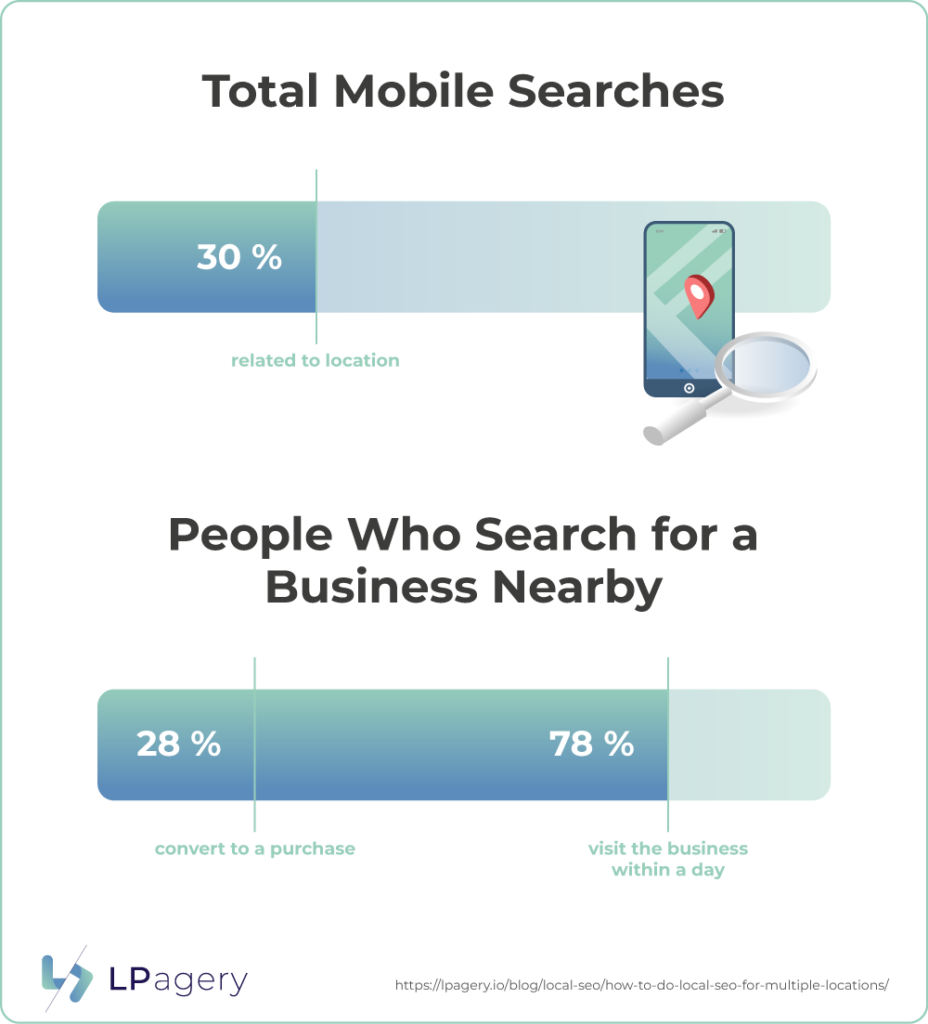
I’ve personally helped over 100 local businesses in a franchise system achieve top 3 rankings in local search results (including “Near me” searches). These proven strategies have consistently delivered results, helping businesses attract more customers, boost sales, and grow their revenue—without spending a dime on ads. I will show you the techniques I used to achieve these results in this article!
Whether you’re just starting with local SEO or looking to refine your existing strategy, I’ll guide you step by step to ensure your business thrives in “near me” searches.
So if you want to rank in the nice area highlighted in this screenshot, you’re in the right place!
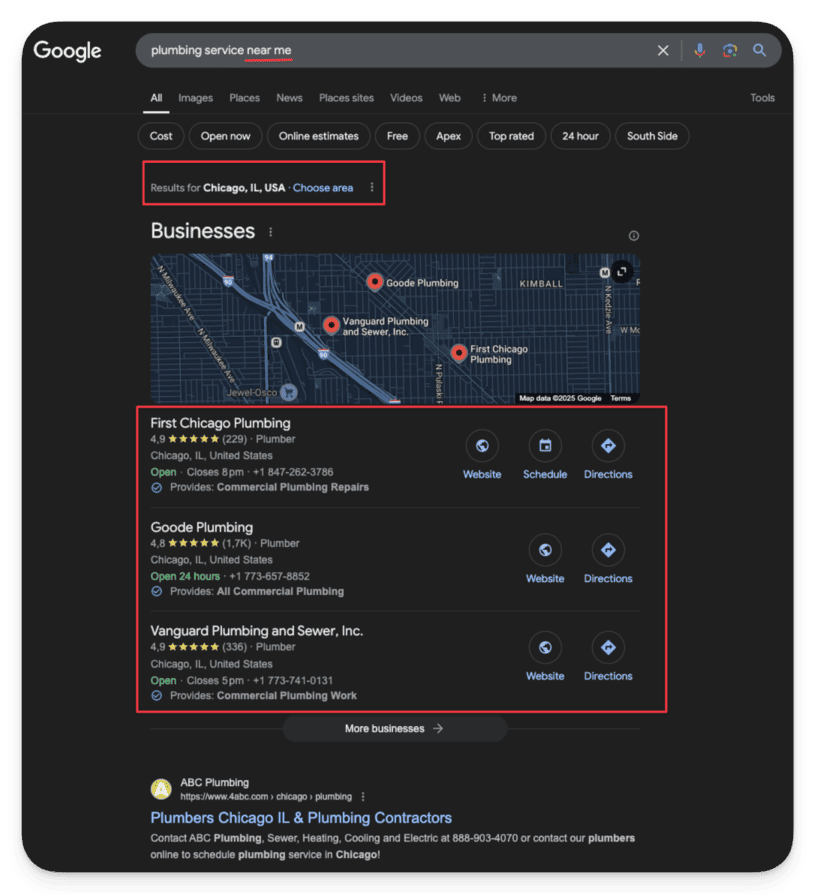
Why “Near Me” Searches Matter for Your Local Business
- High Intent: People using “near me” searches are often ready to take immediate action, like visiting a store or booking a service.
- Local Opportunity: If your business shows up in these search results, you’re more likely to attract customers who are nearby and ready to buy.
Important: “Near me” is not a keyword you need to include on your site. Google automatically interprets a “Near me” search based on the user’s location and your business information.
What This Guide Will Teach You
In this article, we’ll cover:
- How Google (and other search engines) determines results for “near me” searches.
- The role of local SEO (Local Search Engine Optimization) in targeting these queries.
- How to rank for “near me” searches even if your business location isn’t physically near the user.
- The importance of local landing pages and how they help you expand your reach.
Now I’ll show you how “Near me” searches work and how you can get to the top of the local SEO rankings.
Understanding Google’s “Near Me” Searches
When a user searches for something like “best restaurants near me,” Google uses several factors to show the most relevant results.
- Proximity: Google checks the user’s location and prioritizes businesses that are physically nearby.
- Relevance: The search engine looks for businesses or pages that closely match the query.
- Prominence: Well-known businesses or those with strong online reviews and a good reputation are more likely to rank higher.
Key Ranking Signals for “Near Me” Searches
- Google Business Profile: Accurate and up-to-date business information, including address, phone number, and hours, is essential.
- Online Reviews: Positive reviews and high ratings signal trust and quality to Google.
- Local Keywords: Using location-specific phrases in your content helps your website appear in relevant local searches.
Example: How It Works
If a user searches for “coffee shop near me” while in downtown Los Angeles, Google identifies their location and displays coffee shops within a few miles. If a coffee shop has strong reviews, detailed business information, and keywords like “coffee shop in Los Angeles” on their website, it is more likely to show up in the results.

Even if your business isn’t physically near a user, you can still rank for “near me” searches by targeting areas you serve and optimizing your location pages.
This is how Google connects local search queries with businesses that match the user’s location and intent.
Local SEO = Near Me SEO (Mostly)
To rank for near me searches, your business needs strong local SEO. Google relies on signals like your , business listings, and website content to determine if your business is relevant to a local search query.
Key Components of Local SEO for “Near Me” Searches
- Google Business Profile:
- Keep your profile updated with accurate information, including your address, phone number, and business hours
- Use location-specific keywords in your profile description.
- Respond to positive reviews to show engagement and trustworthiness.
- Online Reviews and Ratings:
- Encourage satisfied customers to leave reviews on Google and other platforms.
- Respond to reviews, both positive and negative, to show you care about customer feedback.
- Consistent Business Listings:
- Ensure your information is consistent across all platforms, including local directories and review sites.
- Inconsistent business details (like a mismatched phone number) can confuse search engines and hurt your rankings.
Local SEO is the foundation for ranking in “near me” searches. Without a well-optimized online presence, your business may not appear in these high-intent queries.
Ranking for “Near Me” Searches in Areas You Serve
Appearing in local search rankings is not only possible for areas in direct proximity to your physical location but also for all areas you serve.
Can You Rank for “Near Me” Searches Outside Your Location?
Yes, your business can appear in near me searches for areas where you provide services, even if your main location isn’t physically near the user and it’s easier than you might think. Google (and other search engines) prioritizes relevance and service area details in addition to proximity.
So for the example query from earlier we can see that when we scroll down we get the regular organic Google search results which contains regular pages. You can appear in these pages by creating dedicated pages for areas around you.

How to Rank for “Near Me” Searches in All Areas You Serve
- Create Location-Specific Landing Pages:
- Build individual pages for each city or neighborhood you serve.
- Use location-based keywords like “plumber in Brooklyn” or “landscaping services in Downtown Chicago.”
- Include specific information about your services in these areas to make the pages relevant for local searches
- We will go deeper into this topic in the section “Examples of “Near Me” Optimization“
- Use Structured Data for Service Areas:
- Add proper schema markup to your website to define the areas your business serves.
- This helps search engines understand that your services extend beyond your physical location.
- Internal Linking:
- Link these location-specific pages to your homepage and other relevant pages on your website to improve their authority. We have a dedicated article on how to do internal linking for SEO you should check out.
- Create Local Content
- Creating content that is relevant to each area you serve is also a very nice way of suggesting Google that you know your area and the people who live there. This way Google trusts you more and ranks you higher. You can also use user generated content from local customers as testimonials so potential new clients directly see, that you already serve others from their area.
- Update Your Google Business Profile:
- List all the cities or regions you serve in the “Service Areas” section.
- This signals to Google that your business should appear in near me searches in those areas.
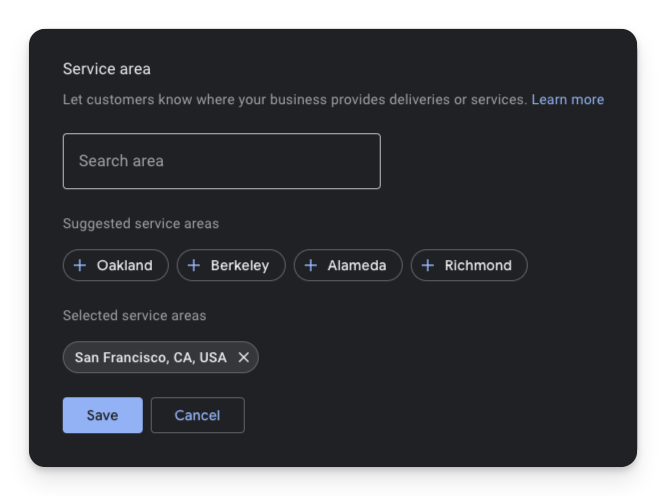
Example: Landscaping Business Serving Multiple Areas
A landscaping company based in Houston creates landing pages for nearby suburbs like Sugar Land and Katy. Each page includes:
- Location-specific keywords like “landscaping in Sugar Land.”
- Details about the services offered in that area.
- Photos and testimonials from local customers.
By optimizing for these areas, the company ranks in local search results for users in both Houston and the suburbs.

Use keyword research to identify the most popular local search terms in each service area and incorporate them into your content.
To learn how to build high-quality location pages, check out our guide on Local SEO Landing Pages
Examples of “Near Me” Optimization
We have two examples of common use cases for “Near me” optimization to give you an idea on how these steps could look like in a real world scenario. The two examples are different as the Coffee Shop has a physical location for which it needs to rank. The Home Repair Service business has a certain area they target and which they need to optimize their local SEO for. But this is also applicable for other local businesses.
1. Coffee Shop Example
A coffee shop in Boston wants to appear in near me searches for “coffee shops near me” and “best café near me.”
Steps to Optimize
- Google Business Profile: Ensure the profile lists the correct business address, contact information, and updated business hours.

- Website Optimization: Add a location-specific title and meta descriptions, like “Boston’s Favorite Coffee Shop”

- Reviews and Ratings: Encourage satisfied customers to leave positive reviews mentioning the Boston location.
- Local Landing Pages: Create dedicated pages for areas in Boston around the Coffee Shop. For example we could add pages for the areas: Back bay, South End, South Boston, North End and West End as they are all in close proximity. This is also a good technique to do local SEO for multiple locations.
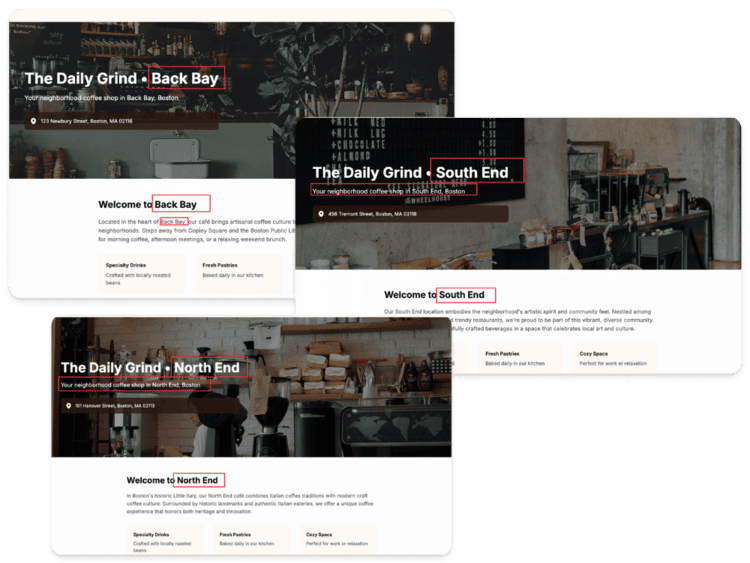
Pro Tip: If you’re on WordPress, check out our article on how to bulk create pages in WordPress. There we go over techniques that let you easily create these pages for all areas around you in just a couple of minutes.
2. Home Repair Services Example
A plumbing business in Austin wants to rank for near me searches like “emergency plumber near me” or “24-hour plumbing near me.” Each created page should be unique for the area it is created for. You can achieve this by using unique images on each page and embedding google maps widgets that signal to the user (and Google) that you are operating in that area.
Steps to Optimize
- Service Area Pages: Create landing pages for areas like South Austin or Round Rock, including keywords such as “emergency plumbing services in Round Rock.”
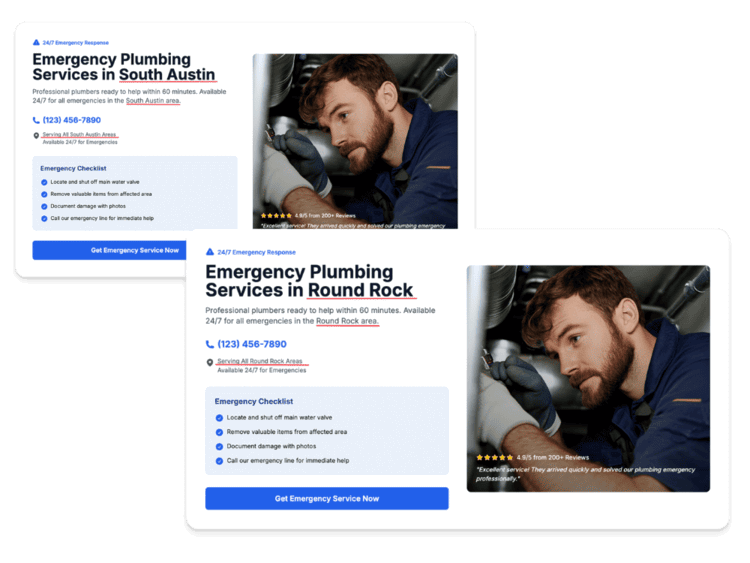
Pro Tip: If you’re on WordPress, check out our article on how to bulk create pages in WordPress. There we go over techniques that let you easily create these pages for all areas around you in just a couple of minutes.
- Structured Data: Use schema markup to define service areas and operating hours. You can learn more about structured data for local businesses in our article on local business schema.
- Internal Links: Link these pages to the main service page to enhance relevance.
- Online Reviews: Request reviews from clients in each service area to strengthen local credibility.
Why These Strategies Work
These examples illustrate how businesses can tailor their local SEO strategy to target near me searches effectively. By optimizing both their website and online profiles, they increase their chances of appearing in local search results, attracting potential customers who are actively looking for services.
Learn More About These Strategies:
- How to Create Local Landing Pages
- How to Create Local SEO Schema
- How to Add Internal Links
- How to Get More Reviews
Combine online optimization with offline efforts, such as providing business cards with your website’s URL and encouraging word-of-mouth referrals.
The New Way People Search: “Near Me” Queries via ChatGPT and AI
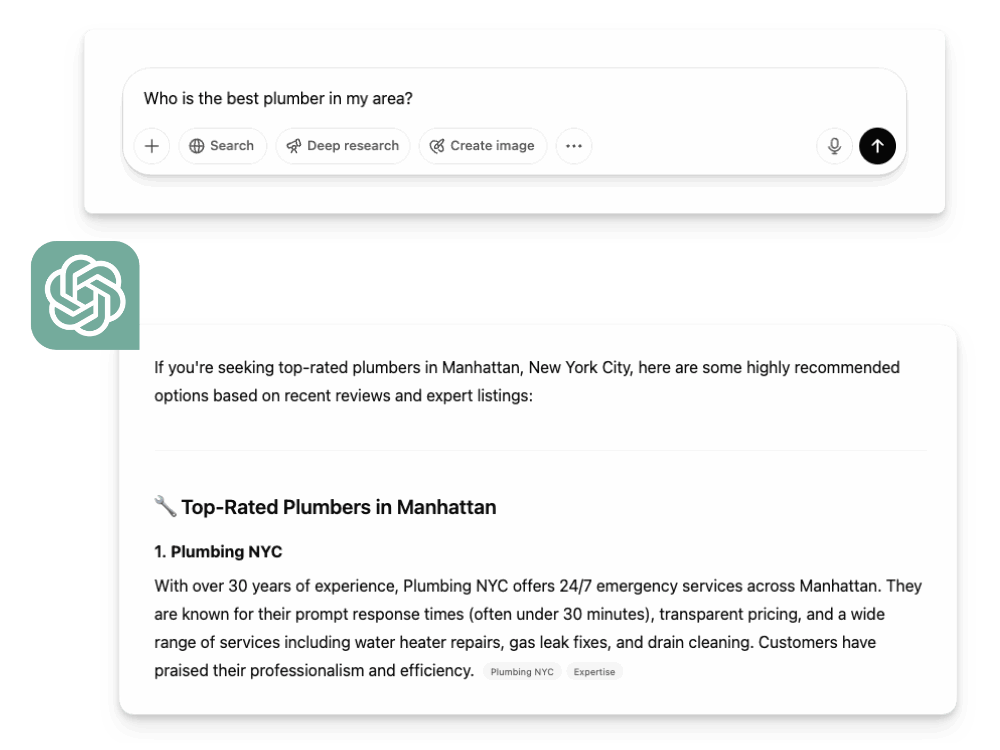
Why AI Assistants Like ChatGPT Matter for Near Me SEO
“Near me” searches aren’t just happening on Google anymore. A growing number of users are turning to AI-powered tools like ChatGPT, Bing Chat, and Google SGE to find local businesses.
Instead of typing “plumber near me” into Google, users now ask ChatGPT directly, expecting an instant, tailored response. Queries like:
Examples of real prompts include:
- “What’s the best coffee shop near me?”
- “Can you recommend a reliable electrician nearby?”
- “Find a 24-hour dentist in my area.”
These are real prompts that AI assistants process daily. If your business isn’t showing up in those AI-generated answers, you’re leaving traffic, visibility, and revenue on the table.
Key Stats to Know:
- ChatGPT’s share of search queries grew by 740% in the past year (SparkToro, 2025)
- 32% of consumers now use AI to find local businesses (Near Media, 2024)
- 67% of experts believe AI assistants will replace traditional search within 3 years
Generative AI is no longer the future — it’s happening now.
What is Generative Engine Optimization (GEO)?
To appear in AI search results, you’ll need to go beyond traditional SEO. That’s where Generative Engine Optimization (GEO) comes in.
Unlike Google, ChatGPT doesn’t display a list of links. It summarizes the most relevant information from across the web — and only mentions a few top businesses.
To rank, your content must be:
- Relevant: Directly answers the user’s question (e.g. “best plumber in Austin”)
- Credible: Includes reviews, stats, or expert quotes
- Clear: Well-structured, readable, and easily understandable
Read the full guide here:
Rank Higher in ChatGPT: The Ultimate GEO Guide
You’ll learn exactly how to optimize your content for AI visibility, including structured data, landing page structure, and GEO-specific content formatting.
How to See If You Rank in ChatGPT for “Near Me” Searches
Curious if your business already shows up in ChatGPT answers? We built a free ChatGPT Rank Tracker just for that.
It analyzes your site, simulates local AI search prompts, and checks if your business is mentioned in ChatGPT’s answers.
Here’s what it shows you:
- Whether you’re mentioned in AI answers
- Which areas you’re visible in
- Which queries you’re missing out on
- Recommendations for content improvements
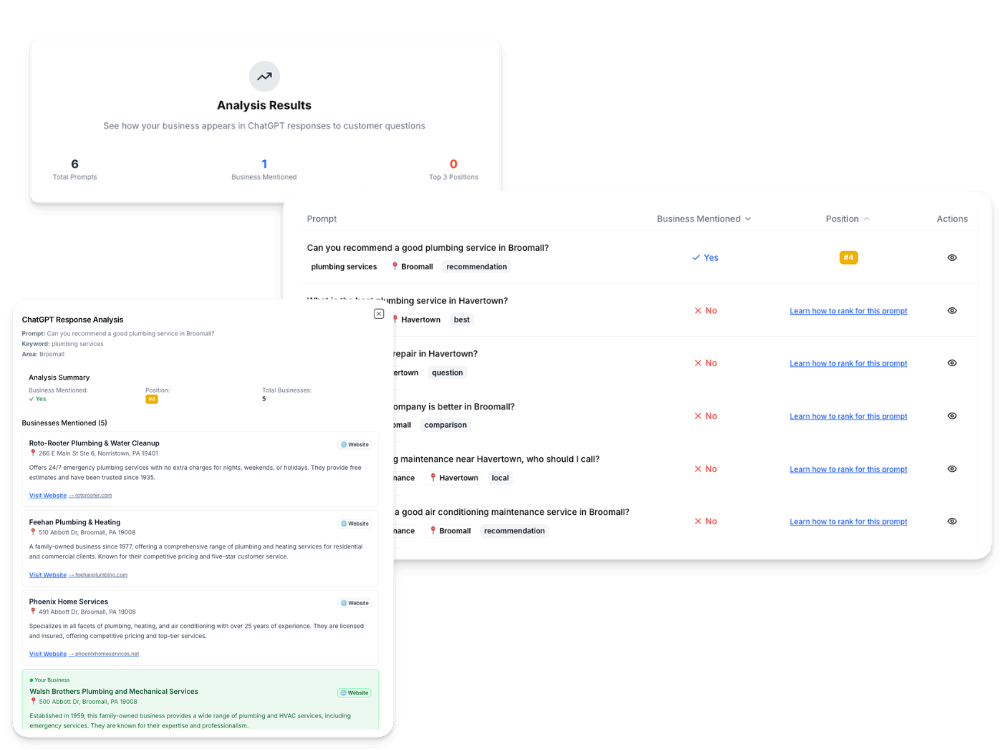
Check your visibility now:
ChatGPT Rank Tracker
Pro Tip: Use this alongside your regular SEO audits to catch visibility gaps you didn’t know existed.
Conclusion: Near Me SEO
“Near me” searches have become one of the most powerful ways for local businesses to connect with . These searches signal high intent, meaning users are ready to visit a business or book a service immediately. By optimizing for near me searches, you can significantly boost your visibility, website traffic, and overall customer engagement.
Key Takeaways
- Understand How Google Works: Proximity, relevance, and prominence are critical for ranking in local search results.
- Focus on Local SEO: Optimize your Google Business Profile, gather positive reviews, and use location-specific keywords.
- Expand Your Reach with Landing Pages: Even if your business isn’t physically near the user, you can still rank in their near me searches by creating optimized location pages for areas you serve to appear in relevant local search rankings.
- Stay Consistent: Ensure your business details, such as address and phone number, are consistent across your website and local business directories.
- Monitor Search Results
- You can use tools like the Google Search Console to easily monitor how much traffic you get from your local keywords and also identify new keywords potential clients might be looking for.
To go deeper into optimizing for local SEO, check out our other helpful articles:
- Local SEO Guide for Multiple Locations for strategies to improve your local search rankings.
- Local SEO Landing Pages for tips on creating effective, targeted pages for specific areas.
Pro Tip: Make “near me” optimization an ongoing part of your Near Me SEO strategy. Regularly update your local content, gather new reviews, and monitor your performance in to stay ahead of the competition.

